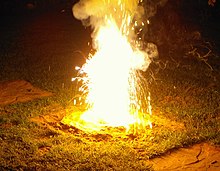Aluminothermics

The aluminothermy is frequently used laboratory technique and thermite reaction for production of metallic elements E from the corresponding oxides EO by the reaction with elemental aluminum according to the following equation:
The process was first carried out in 1894 by Hans Goldschmidt and is therefore often referred to as the Goldschmidt process . The aluminothermics (often also called simply "alumothermics") makes use of the particularly high affinity of aluminum for oxygen , which is the actual driving force of the reaction :
- .
The aluminothermic reaction is strongly exothermic , the temperatures reached are up to 2450 ° C in places, so that the entire reaction mixture is present as a melt. Nevertheless, the reaction needs to be initiated by a “ firing cherry ” (usually a mixture of magnesium and barium peroxide ). In modified variants of the reaction (especially in the extraction of boron and silicon ), elemental sulfur is also added. After the reaction has taken place, the (semi) metal obtained can be broken out of the slag in the form of a regulus .
In this way, among other things, the elements iron (Fe) can be produced in the thermite process , but also chromium (Cr), manganese (Mn), titanium (Ti), zirconium (Zr), boron (B) and silicon (Si). Aluminum oxide is produced as a by-product .
On an industrial scale, aluminothermics are used where the cheaper reduction by carbon is not possible ( e.g. due to the formation of carbide as a side reaction ), for example in the non-electrolytic extraction of chromium.



